|
TennisOne Lessons Bring the Match (Stress) to Your Practice Jerôme Inen So you are on the practice-courts. You are hitting everything beautifully, finding your spots and swinging with the least amount of effort. Perhaps you are using the old Timothy Gallwey-tip of silently mouthing ‘bounce’ when the ball bounces and ‘hit’ when the ball hits your racquet. Perhaps you are using visual strategy this author described in his article ‘Don’t lose YOUR focus.’
Well, my advice is: step back on the tennis court. Call up the method you just used before to play so well… and then start imagining terrible things. Your opponent of your next league-match, standing at the far end of the courts, scouting you. A boom box hidden behind the fence playing Lady Gaga (’Ga-ga-na-na-na!’). Your boss suddenly popping by because he wanted to check out ‘if you are any better on the tennis courts than in the offices’. See you if you can imagine that and, at the same time, focus on the bounce of the ball on the ground and the hit against your racquet. If you are able to salvage some focus on the process despite defocusing yourself, you’re on your way to become a better match player. If you are a novice tennis player or a seasoned pro and you now recoil in horror, thinking this author must be a sarcastic, ‘If you can’t stand the heat get out of the kitchen’-kind of tennis coach, be assured, I’m not. I think that the spiritual wave in tennis, once set in motion by Timothy Gallwey, and now held high by people like Jackie Reardon, Jeff Greenwald, and on this site, by Happy Bhalla, is a good thing. It is a good thing to focus on the process of hitting the ball and not on the outcome (in or out, winning or losing the point). It is a good thing to meditate, on and off court. However, with the popularity of awareness in western culture, a fallacy has grown that misleads us both in daily lives and on the tennis court. The fallacy is this: that by using awareness-techniques we can change reality. We are basically using eastern the philosophy of ‘It is as it is’ to fool ourselves. We still think, feel, and demand, that life should not be like it is, but how it should be. Basically, we are using meditation, awareness or whatever you want to call as praying: God, or whoever, let it be thus and not so. I read once (if not true, it is still a good example) that the young Tiger Woods once made the mistake to mention to his father Earl that he hated ‘that song the Macarena’. And that, of course, when Tiger practiced putting the next time, his father would play ‘the Macarena’ on a boom box…
The first time I heard this about Tiger Woods and his father, I thought the same thing as you: ‘Aw, poor kid.’ A couple of years later, however, I realized that though Earl seemed cruel, doing the opposite is perhaps just as cruel. If you, as a coach or father, try to create perfect practice-situations for your pupil or kid… situations where there is no noise, no talking people (right! On the golf course!)… You’re setting them up for an illusion: the illusion that they can create, during match play, the same perfect situation as in practice. Are You Really Just Playing For Pleasure? The things I am writing about are ‘situational realities’. I am going to talk about them further, and how you can train yourself for them. But there is also something like ‘mental reality’. If there is one mantra in the whole awareness-industry it the sentence: ‘Let it go.’ First and foremost we are told to let go of our ambitions, the things we want to achieve. Winning matches, impressing our friends (or our boss), etc. Now as most of you know, Timothy Gallwey, the father of awareness in tennis, thinks we should not do that. In his book The Inner Game of Tennis (first edition 1972) he states that this is our ego talking, or, as he calls it ‘Self-1’. Self-1 is always looking for confirmation. While Self-2, or our deeper consciousness, doesn’t need that confirmation. It can revel in experiencing, enjoying the moment. It is like a child, playing, being there. Gallwey is followed by most ‘mental coaches’ whose advice is to give up the outcome, to consciously battle the idea that winning, impressing our friends or ambitions like that have any real meaning.
Well, perhaps in the broadest, philosophical sense, winning doesn’t mean anything, not even when you are in the final of Wimbledon. But lets take the mental reality in view. Many tennis players say: ‘I just want to play a good match, win or lose.’ Perhaps you are one of them. But ask yourself, and be honest. Are you really just playing for pleasure? Are you really able to give up the result? Don’t you really want to impress tour boss with your work? Don’t you really want to impress your friends? Don’t you really want to win that match? I think that ‘letting go of the result’ is a gift bestowed on very, very few people. In fact, I think that the only people who are able to do that, are the people who in their whole life let go of everything. Who don’t have regular jobs, who don’t have mortgages, perhaps not even a regular place to sleep. I recently read about a woman who travels the world with her kids in a caravan, and teaches yoga-classes in the places she visits. Well, that is one person who really let go of regular life! We, the general public, don’t have a life like that, most of that don’t even want to have a life like that. We can kid ourselves we would like to live like gypsies, but if we really, really would like to be gypsies, we would be a gypsy. You can say that is ‘wrong’, or ‘not enlightened’. You can beat yourself up for having those desires. But that is, again, a fallacy. It is a denial of the mental reality. If you care about winning, you care about winning. But how about the Zone, or being in the Flow? Doesn’t that exist? Absolutely. There is a certain stream you sometimes enter as a human being or as tennis player. A stream in which we only focus on the process, a stream in which the outcome — in or out, win or lose — disappears. But… it is a gift that can be received… and be taken away. It can last one rally, a game, or in very, very few instances a whole set. But on average sooner than later, we step out of that stream of consciousness, and stare reality in the face: a breakpoint for, or against us. A match point. A chance, or just perhaps an idea of a chance. And then we are stuck between the devil and the deep blue sea. We don’t seem to able to enter the stream/zone/flow anymore, and there is nothing to fall back onto. Include, Don't Lock Out If we see ambition (or desire to win) as something very real and as something we have to accept as a given, we also see that distractions outside of our mind should also be accepted. They should be included in our awareness, and not locked out. It doesn’t mean you should ‘accept’ all distractions. If you are playing tennis and someone is having a loud conversation about six feet from your ear, or smoking a cigarette of which the smoke drifts right into your nose, please do object. And ask the person in question: ‘Excuse me, would you mind doing that somewhere else?’ My first advice: play with it. The general advice for meditation is: ‘Meditate in a place where you can be alone and undisturbed.’ While I concede that for relaxation and practice-purposes this is sound advice, if you want to be able to be aware during ‘normal life’ (and that is including on the tennis court!) it won’t do. At a certain point, thoughts will occurs. Is my neighbor watching me from the garden? Have I’ve bought all the groceries? Why hasn’t that friend called back after that nice e-mail I sent her? At the same time, however quiet as that place you chose is, you can hear sounds. Dogs barking further down the street. Perhaps sirens of a police-car. The air conditioner you switched off making small, ticking sounds. Now, there are two ways to react to both the sounds and the noises; a wrong one and another wrong one. The first wrong one is of course to be annoyed, to start thinking: ‘Just my luck. Here I want to meditate and there’s all this distraction.’ The other wrong one is to start pushing away those thoughts. ‘Get out, get out, get out!’ ‘No, you should let those thoughts go,’ sage yogi will say. But only yogis are able to do that. I suggest trying something else: don’t push those thoughts and sounds away. Let them in, invite them in, try to make them bigger, as bigger as your head will allow. Imagine your head is a big, echoing church, where the sounds are loud close, and softer the more the sounds have echoed in that big space.
This may perhaps sound very philosophical, but actually it is very factual. Take the dog barking outside. You experience this sound as something outside of you. You are here, the dog is there, and the sounds come to you, from outside to inside your head. But that is not what happens. On your head, you have ears. In your ears there are eardrums, little pieces of flesh that vibrate when sound enters. The vibrations are translated by your brain as sounds, in this case: a dog. So the dog barking happens inside your head, not outside of it! When you are playing tennis, focus on a routine that works for your game and at the same time be aware of your surroundings… and your thoughts. Say that you have established that when you breathe in as the ball bounces on your side of the court and exhale when the ball hits your racquet, you focus best. That all other thoughts disappear. Fine. Now a good friend, whose opinion and admiration you value very much, is sitting next to the court. Or not. If she is not there, imagine she’s there. And despite the fact that you are aware she is there, you still focus on bounce/breath in, hit/exhale. A couple of years ago, I did a similar thing. Because I wanted to strengthen my own focus-method (watching the hitting point), during practice I started imagining that the head coach of the club was watching (for whom I worked at that time). I did that specifically, because the last two times he came to watch my matches, I started playing lousy. It took me a couple of weeks, first just the thought of him watching would throw me off the deck, but, sure enough, during practice I could focus on the right thing while still imagining he was watching me. Then the strangest thing happened. The next two matches I played, he showed up half way during the match. And when I knew he was watching I played better than before he was watching! So: practice focusing and awareness during all kinds of activities and distractions, be it nice or annoying. My second advice: play points all the time. For about thirty years I believed that during practice you tried to hone your technique and in general find your rhythm. And then ‘transfer’ that rhythm to the playing of points during practice. At a start of a match I did the same: during the warm-up and beginning of the match. I tried to iron out little technical glitches and tried to find a nice groove, a nice rhythm. Don’t. From the moment you open a call of balls, start putting yourself under ‘point-stress’. Are we going to practice hitting crosscourt forehands? Fine. But I want to make fewer mistakes than the guy at the other site of the net. Are we going to practice smashes? I am not killing all the smashes but still I am going to make fewer mistakes than my ‘opponent’. Are we practicing serves and returns? I am not going to ace every ball, but I am going to put pressure on my practice-partner and make sure he makes less returns than I hit serves in.
My third advice, and perhaps the most important one: don’t try to ‘forget’ your ambitions. Don’t start berating yourself: ‘Forget winning or losing, focus on the process, focus on the process!’ That is just like: ‘Don’t think of the pink elephant.’ If you say that, you will think of the pink elephant, I guarantee it. Be aware of your desires and ambitions. A healthy line of thought could go like this: ‘Gee, breakpoint. I really want to win this point. I really, really, want it, I feel my hand sweating. Okay. My hand is sweating. I am a bit shaky. What should I do next? Focus on breathing/hitting point. Try to score immediately with a long… no, no, I am too nervous for that. Be secure. Get the ball crosscourt, to his backhand on the first occasion. Let’s go.’ Of course you should not think this much and this verbally in between points. But you get the idea. The trick is to be aware of everything, and that includes what you want to achieve. Embrace your ambition, if you have it, it is who are you are. As Timothy Gallwey wrote in The Inner Game of Tennis: ‘The last thing I wish to do is to encourage any notion that you should be any different from what you are right now. I say this with great conviction because I spent many not-so-happy years trying to become "better" than I thought. I was, trying to change into somebody I thought I should be. In my eagerness to achieve that "should," I found it easy to lose touch with the sense of who and what I truly was — and of course still am.’
Your comments are welcome. Let us know what you think about Jerôme Inen's article by emailing us here at TennisOne.
"I’ve learned tennis the traditional, form-oriented way — and it is not the right way! Lijftennis is my attempt to show other people a way to learn quicker, with better results and less frustration. If I have one message: don’t copy others, play and learn from your own body and perspective!" |
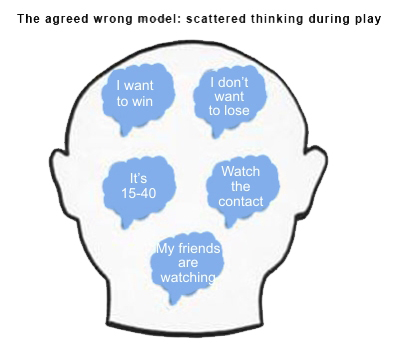 Whatever it is, there are hundreds of these kinds of ‘awareness’-helpers for tennis, it is helping you NOW to play at your best, by taking the focus away from nerves, from your technique (or lack thereof!), by freeing you of the outcome and focusing you on the process. You are in the zone, you are in the flow.
Whatever it is, there are hundreds of these kinds of ‘awareness’-helpers for tennis, it is helping you NOW to play at your best, by taking the focus away from nerves, from your technique (or lack thereof!), by freeing you of the outcome and focusing you on the process. You are in the zone, you are in the flow.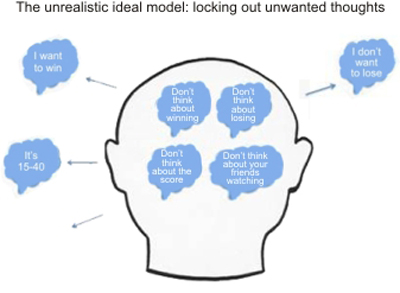 True or not, it is a matter of history that Earl Woods saw dealing with distractions an important lesson for his son. To quote an article from
True or not, it is a matter of history that Earl Woods saw dealing with distractions an important lesson for his son. To quote an article from  Here’s an exercise, for beginners in meditation as well as people who are perhaps already familiar with it. Find that quite spot we were talking about. Let’s say it’s your living room, or a quite place in your office. Sit down and close your eyes. You don’t have to take the lotus-position (that is so overrated!), any comfortable position will do. Focus on your breathing, in, out, in out.
Here’s an exercise, for beginners in meditation as well as people who are perhaps already familiar with it. Find that quite spot we were talking about. Let’s say it’s your living room, or a quite place in your office. Sit down and close your eyes. You don’t have to take the lotus-position (that is so overrated!), any comfortable position will do. Focus on your breathing, in, out, in out.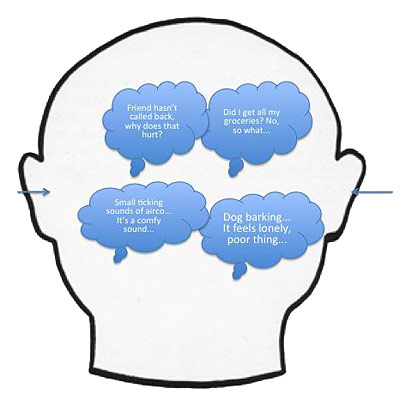 If you are able to do this, something strange will happen: what first appeared as intrusion, will now be welcome, something of yourself. Your opinion about it — nuisance or welcome? — may very well change.
If you are able to do this, something strange will happen: what first appeared as intrusion, will now be welcome, something of yourself. Your opinion about it — nuisance or welcome? — may very well change.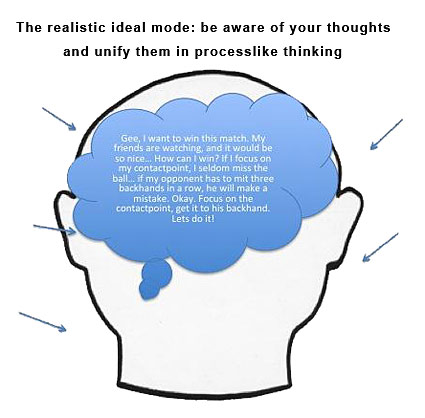 The same applies to warm-ups for matches. Of course you are not going to make your opponent run from the word ‘go.’ Hit the ball to him, by all means. But from ‘Ball Number 1’ try to dominate proceedings, as if points count already. Hit with just enough speed, spin, and tempo you can control and only be satisfied with the warm-up when he makes more mistakes during the warm-up than you do.
The same applies to warm-ups for matches. Of course you are not going to make your opponent run from the word ‘go.’ Hit the ball to him, by all means. But from ‘Ball Number 1’ try to dominate proceedings, as if points count already. Hit with just enough speed, spin, and tempo you can control and only be satisfied with the warm-up when he makes more mistakes during the warm-up than you do.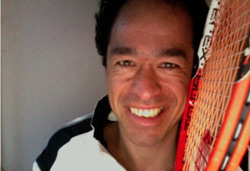 Jerôme Inen of
Jerôme Inen of